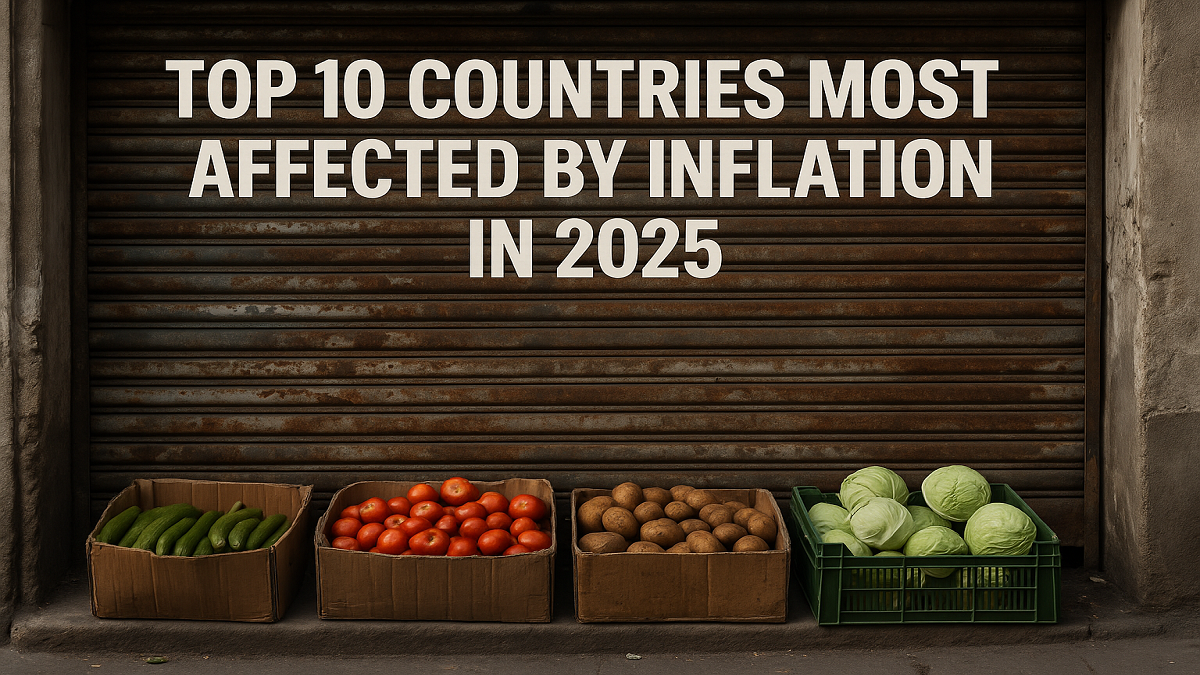Inflation remains one of the most pressing economic challenges of 2025, particularly in developing nations and politically unstable economies. While many countries have begun to stabilize after the inflation shocks of the early 2020s, others continue to suffer from skyrocketing consumer prices, currency depreciation, and economic mismanagement.
This article takes an in-depth look at the top 10 countries most affected by inflation in 2025, examining the causes, consequences, and global implications of prolonged inflationary pressure.
Understanding Inflation in 2025
Inflation refers to the general increase in prices of goods and services over time, resulting in a decline in purchasing power. Moderate inflation is normal in healthy economies, but hyperinflation or high single-to-double-digit inflation can erode savings, distort investment, and push populations into poverty.
In 2025, inflation is being driven by a combination of factors:
- Global energy price volatility
- Currency devaluation
- Post-pandemic fiscal imbalances
- Geopolitical conflicts and trade disruptions
- Extreme weather events impacting food supply
Top 10 Countries Most Affected by Inflation in 2025
| Rank | Country | Estimated Inflation Rate (2025) | Key Drivers |
|---|---|---|---|
| 1 | Argentina | Over 140 percent | Fiscal deficit, currency devaluation, monetary issues |
| 2 | Venezuela | Around 120 percent | Hyperinflation legacy, sanctions, oil collapse |
| 3 | Lebanon | About 95 percent | Currency crash, political crisis, banking collapse |
| 4 | Zimbabwe | Over 85 percent | Monetary instability, gold-backed reforms |
| 5 | Turkey | Around 65 percent | Lira depreciation, policy missteps |
| 6 | Sudan | Near 60 percent | Conflict, economic breakdown |
| 7 | Nigeria | About 50 percent | Fuel subsidy removal, naira float |
| 8 | Pakistan | Around 45 percent | External debt, energy import shocks |
| 9 | Egypt | Close to 40 percent | Food and fuel import inflation, currency drop |
| 10 | Sri Lanka | Around 35 percent | Post-default recovery, weak rupee |
1. Argentina: Persisting Crisis Amid Political Turmoil
Argentina continues to experience one of the highest inflation rates globally. In 2025, the country’s annual inflation remains above 140 percent, driven by long-standing fiscal deficits, monetary overexpansion, and loss of investor confidence. Despite repeated reforms and IMF interventions, inflationary pressures have not been sustainably reduced. Citizens face skyrocketing prices for basic goods, and the peso continues to lose value on the parallel exchange market.
2. Venezuela: Hyperinflation Remains a Structural Problem
Despite a slight reduction from peak hyperinflation years, Venezuela still suffers from three-digit inflation, hovering around 120 percent in 2025. The Bolivar remains severely devalued, and dollarization has become widespread in urban centers. Political instability, reduced oil output, and sanctions have prevented any real macroeconomic recovery, making inflation a persistent and structural issue.
3. Lebanon: Economic Breakdown Fuels Price Instability
Lebanon’s economy continues to be in deep crisis. In 2025, inflation is estimated around 95 percent, following years of currency collapse, banking sector paralysis, and political deadlock. The Lebanese pound has lost over 95 percent of its value since 2019. Food and fuel prices have skyrocketed, and public services have nearly collapsed, fueling mass migration and social unrest.
4. Zimbabwe: Inflation Returns Despite Past Reform Attempts
Zimbabwe once again finds itself battling inflation rates exceeding 85 percent in 2025. Despite monetary policy reforms, including the introduction of the gold-backed digital Zimbabwe dollar, structural weaknesses like corruption, a lack of investor confidence, and reliance on imports have reawakened old inflationary demons. The informal economy has grown as citizens seek alternative survival strategies.
5. Turkey: Currency Devaluation and Unorthodox Policy
Turkey’s inflation, although lower than its 2023 peak, remains dangerously high at around 65 percent in 2025. The Turkish lira continues to depreciate amid politically influenced monetary policies and capital outflows. Persistent current account deficits and high energy costs have further strained household budgets, making food and housing less affordable for millions.
6. Sudan: Conflict and Economic Collapse
Sudan has been dealing with both civil unrest and economic freefall, leading to inflation rates near 60 percent. With institutions weakened, public debt surging, and supply chains broken, price levels for essential goods have exploded. Food insecurity is rising, and the Sudanese pound continues to plunge against major currencies.
7. Nigeria: Fuel Subsidy Removal and Currency Reforms
In 2025, Nigeria faces inflation of around 50 percent, largely driven by the removal of fuel subsidies and a currency float policy that has led to naira devaluation. While the reforms were intended to attract foreign investment and reduce fiscal pressure, they also triggered immediate spikes in transportation, food, and energy prices, disproportionately affecting low-income households.
8. Pakistan: External Debt Crisis and Energy Shocks
With inflation reaching approximately 45 percent, Pakistan struggles with external debt obligations, fluctuating fuel prices, and heavy import dependency. The Pakistani rupee has weakened, and price volatility in essential commodities like wheat and fuel continues to burden the population. IMF-supported austerity has also reduced subsidies and lifted utility rates.
9. Egypt: Currency Devaluation and Food Inflation
Egypt’s inflation rate stands around 40 percent in 2025 due to currency devaluation and rising food prices. Heavy reliance on imported grain and energy has made Egypt particularly vulnerable to external shocks such as war in trade corridors and global price hikes. Central bank rate hikes have failed to curb core inflation effectively.
10. Sri Lanka: Lingering Effects of Sovereign Default
After its 2022 sovereign default, Sri Lanka is still grappling with economic recovery. In 2025, inflation remains around 35 percent, especially affecting food and fuel. IMF assistance and tourism recovery have helped stabilize some indicators, but household purchasing power remains weak, and currency depreciation continues to elevate import costs.



 Indian Navy to Commission INAS 335 (Ospr...
Indian Navy to Commission INAS 335 (Ospr...
 Indian Navy to Commission First Indigeno...
Indian Navy to Commission First Indigeno...
 Rajnath Singh Inaugurates 125 Border Inf...
Rajnath Singh Inaugurates 125 Border Inf...







